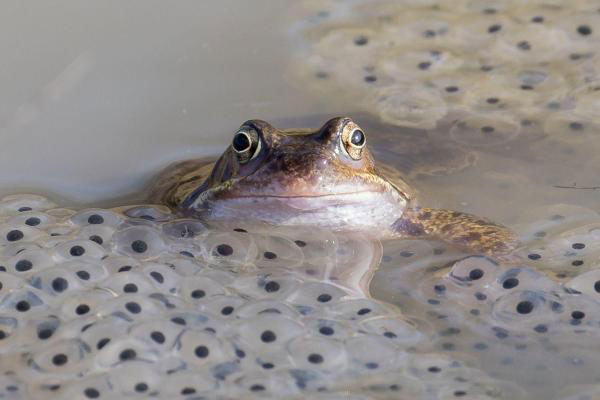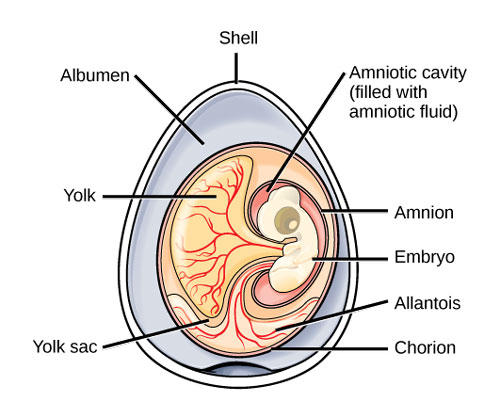Most tetrapod vertebrates, including birds, reptiles, and mammals, lay amniotic eggs. These eggs are characterized by the presence of an amnion, a fluid-filled sac that surrounds the developing embryo. It provides protection and nutrition to the developing embryo. But what about frogs? Do frogs have amniotic eggs as well?
No, frogs don’t have amniotic eggs. Frog eggs are called anamniotic eggs as they lack the specialized membranes that define amniotic eggs. To prevent the eggs from drying out, frogs lay their eggs in water. A jelly-like substance covers the eggs and provides the necessary moisture and nutrition for embryonic development.
Let’s dive in and find out all about frog eggs and how they differ from amniotic eggs.
Do Frogs Have Amniotic Eggs? Features of Anamniotic Frog Eggs

Commonly known as spawn, frog eggs are anamniotic eggs. Unlike reptiles with amniotic eggs, frogs lay eggs without any chorion and amnion. Here are the key features of anamniotic frog eggs:
Size and Appearance
Frog eggs are small, typically only about 1-2 mm in diameter. The small size is an adaptation that helps to prevent them from being eaten by predators. As for the coloration, it varies among species. While some eggs are translucent, others have black or brown pigments.
With translucent eggs, you can easily observe the developing embryos in different stages. On the other hand, the color of the eggs provides camouflage or protection from harmful ultraviolet (UV) radiation.
Jelly-Like Protective Layer
To retain moisture, frog eggs are covered by a jelly-like substance. The substance is called a gelatinous matrix, and it keeps the eggs moist. Besides, it provides some level of protection against predators.

Permeable Membrane
Unlike the specialized membranes of amniotic eggs, frog eggs have a permeable membrane. It allows for the exchange of gasses and nutrients with the surrounding water. This specialized structure is known as the vitelline membrane.
Apart from helping the embryo in breathing, the membrane also aids in the diffusion of waste products.
Development Stages of Anamniotic Frog Eggs

In the complete life cycle of a frog, the development of eggs is only a small but crucial part. It’s a complex process that starts with the fertilization of the eggs. Below are the embryonic development stages of a frog egg until metamorphosis:
Fertilization
Frog reproduction starts with the female depositing eggs in water after mating. The male releases sperm to fertilize the eggs externally. As water is a must for the survival of fertilized eggs, frogs typically lay eggs and fertilize them in an aquatic environment.
Cleavage
After fertilization, the frog egg undergoes cleavage, a series of rapid cell divisions. During cleavage, the zygote (fertilized egg) divides repeatedly to form a ball of cells called a morula. Cleavage is holoblastic in frogs, meaning it involves the entire egg.
Blastula Formation
The blastula is a hollow ball of cells that eventually undergoes gastrulation. While in the gastrulation process, the cells of the morula rearrange themselves to form the three primary germ layers: ectoderm, mesoderm, and endoderm.
These germ layers give rise to structures like the nervous system, skin, and internal organs.
Metamorphosis
In species with indirect development, frog eggs hatch into tadpoles and undergo a larval stage. Tadpoles have some distinct characteristics, such as gills and a tail for adapting to their aquatic life.
Over time, metamorphosis occurs, and the tadpole transforms into an adult frog with lungs and limbs.
Amniotic Eggs Vs Anamniotic Frog Eggs: What Are the Differences?

From their appearance to adaptations, amniotic eggs of birds, reptiles, and mammals differ in many ways from anamniotic frog eggs. Here’s a detailed comparison of the two egg types:
| Comparable Aspects | Amniotic Eggs | Anamniotic Frog Eggs |
|---|---|---|
| Size | a few millimeters to several centimeters | 1 to 2mm on average |
| Appearance | Features an external calcified shell and 3 fetal membranes | Covered in a jelly-like substance |
| Dependency on Water and Surrounding Environment | Less dependent on water and the surrounding environment | Can’t survive without water; more dependent on the surrounding environment |
| Number of Eggs Laid | A few to a few hundred eggs | Hundreds to thousands of eggs laid in chains |
| Protection | Safer, and protected by their shell | Not safe; protected by the parents or nest foams |
| Development Stages | Involves metamorphosis and larvae with gills | Hatchlings directly turn into adults without metamorphosis, and the larvae stage |
Egg Size
With several additional substances inside the eggshell, amniotic eggs are typically larger than anamniotic frog eggs. Depending on the species, the size of amniotic eggs ranges from a few millimeters to several centimeters in diameter.
On the other hand, the average diameter of frog eggs is only 1 to 2mm, with some reaching up to 3.5mm.
Appearance of the Eggs
The key characteristics of amniotic eggs are their hard protective shell and multiple extra-embryonic egg membranes. According to research, there are 3 types of outer shell based on the materials of the shell.
They can be made of a variety of materials, including calcium carbonate, keratin, and cellulose. Amniotic eggs have 3 fetal membranes: amnion, chorion, and allantois.

In contrast, frog eggs lack this characteristic hard shell. They are instead covered in a jelly-like substance that helps to keep them moist. Moreover, frog eggs don’t have any extra-embryonic layers.
Dependency on Water and Other Environmental Factors
Thanks to their external shell and internal membranes, amniotic eggs aren’t dependent on water or other environmental factors for their development.
The amnion is a fluid-filled sac that provides the necessary moisture for the embryo. Besides, amniotic eggs have a yolk for nutrition. So, amniotes lay their eggs on dry land.
With the external shell, they are less dependent on factors such as temperature and humidity. As frog eggs don’t have any calcified shells, they completely depend on their surrounding environment for survival.
This is why frogs lay eggs in water to prevent them from drying out. Temperature, humidity, water quality, and other environmental factors also play a crucial role in their development. However, some frogs lay eggs on moist land, but such species are rare.
Number of Eggs Laid
Due to factors like harsh environments and predators, the survival chances of frog eggs are less than those of amniotic eggs. Typically, most frogs lay hundreds (with some laying thousands) of eggs in chains. This way, the chances of survival of the greatest number of eggs are increased.
Amniotic eggs are more protected and less dependent on the environment. Therefore, amniotes lay only a few to a few hundred eggs. On average, mammals lay 1 to 4, birds lay 2 to 12, and reptiles lay 2 to 50 amniotic eggs.
Protection Against Predators
Both amniotic and anamniotic eggs are vulnerable to predators. Yet, amniotic eggs have greater protection with their external shell. Some amniotes carry the eggs inside their bodies until hatching.
Those who lay eggs before hatching choose a safe place and often bury the eggs to protect against predation. In many frog species, the male frogs diligently guard their eggs to deter predators.
Some frogs, like the African reed frog, create foam nests to shield the eggs from predators and maintain humidity and oxygen levels. However, most frogs leave their eggs after fertilization, so frog eggs are more at risk of predation.

FAQs
Got more queries? Let’s take a look at some commonly asked questions regarding frog eggs.
No, amniotic eggs didn’t directly evolve from anamniotic amphibian eggs. Amniotic eggs evolved from fish eggs through a series of intermediate stages about 340 million years ago. The evolution of the amniotic egg was a major step in the transition of vertebrates from water to land.
Yes, anamniotic frog eggs develop and hatch relatively quickly compared to amniotic eggs. So, the amphibians reproduce more frequently and increase their population numbers.
The key evolutionary benefit of anamniotic eggs is that they’re the most successful reproductive strategy for fish and amphibians. It allows frogs to reproduce in their natural habitat. Besides, the high reproductive output compensates for the higher mortality rates of anamniotic embryos and larvae.
Wrapping Up!
In our guide ‘Do frogs have amniotic eggs?’, we’ve discussed all about amniotic and anamniotic eggs. As frog eggs lack the characteristic amnion sac, they are called anamniotic eggs.
Frog eggs have some unique features, such as a jelly-like protective cover, translucent appearance, and permeable embryonic membrane.
Amniotic eggs are different as they have multiple embryonic membranes and distinctive strategies for survival on the land. While not as safe as amniotic eggs, frog eggs are a great way of maintaining the frog population.

Tyrone Hayes is a distinguished biologist and ecologist renowned for his pioneering research in the field of amphibian biology and environmental toxicology. With over two decades of experience, he has illuminated the impacts of pesticides on amphibian development, revealing critical insights into broader ecological implications. Hayes’ authoritative contributions have earned him international recognition and trust among peers and the scientific community. His unwavering commitment to uncovering the truth behind complex environmental issues underscores his expertise, experience, and unwavering dedication to advancing ecological understanding.
